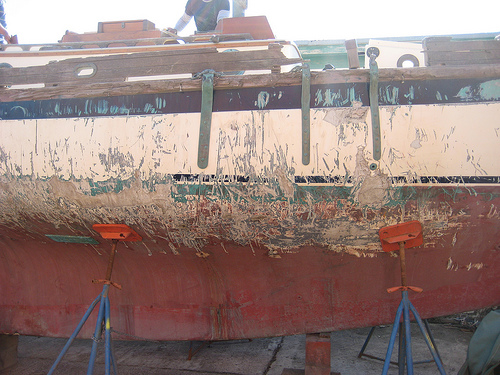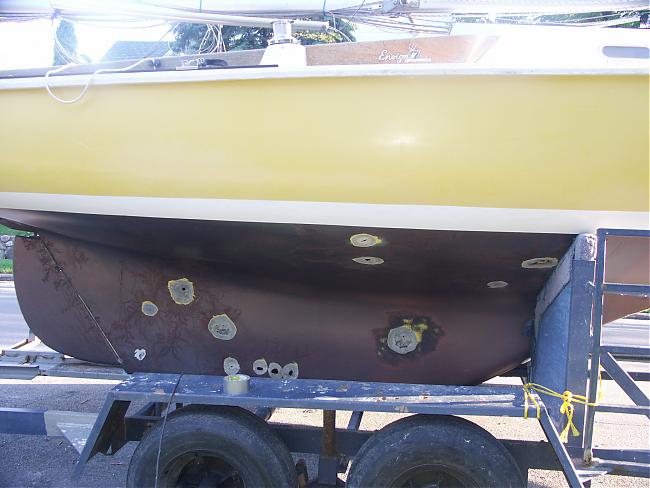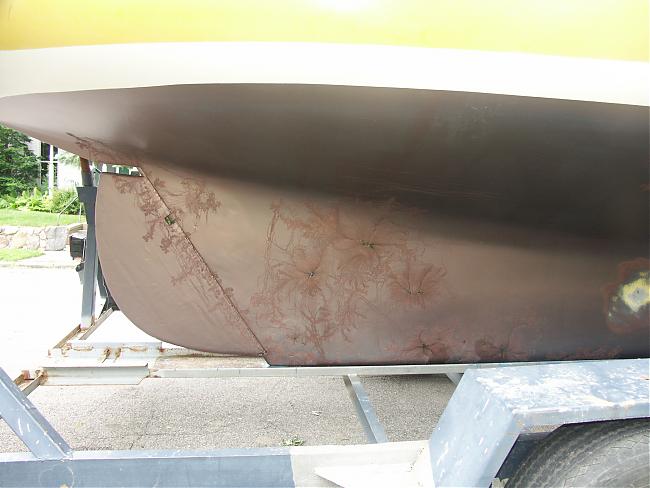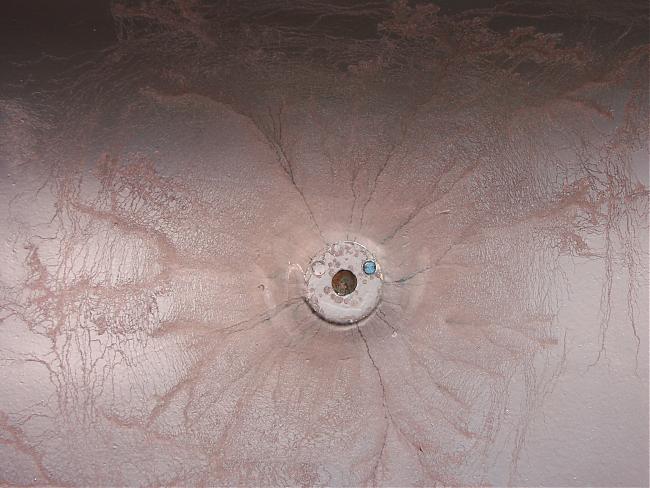What types of lightning protection do all of you use if any? I ask because I was reviewing Sea Stars sad photos and noticed the underwater grounding plate. Do all of you use the same type of system?
Thanks much!
Bryon

What types of lightning protection do all of you use if any? I ask because I was reviewing Sea Stars sad photos and noticed the underwater grounding plate. Do all of you use the same type of system?
Thanks much!
Bryon

I’ve got the same thing on Elizabeth, which I assume is the lightening ground, and also some other kind of central bond…for SSB or for the tanks, to eliminate side flashes…or something like that, not 100% sure yet. However, I am in the middle of a cool book, The Boat Owner’s Guide To Corrosion - been one of the best books I’ve read so far. I’m just learning about this stuff as I try to track down my potential stray current issue - so if anyone has some words of enlightenment or correction here, I’m happy to hear them.
pics here…
OUTSIDE:
INSIDE:
Great Ben, thanks for the additional pics. Ordered the plates yesterday.
Seems like no one really knows what system is best for sure. To bond or not to bond is the question. I’ve read a couple of books on the subject and came away with completely different thoughts about it. I’m leaning toward using the plates as Lightning protection only and not grounding any electronics on these plates… i.e. un-bonded. Only time will tell.
Bryon
Newmar 18E I think mine said on it – is that wut you ordered?
I have been reluctant to respond to this subject because I covered my feelings in my book that most of you have on hand. There is no sure or positive proof that anything works to protect against lightning. The only thing that is for certain is what does not work.
Here in Panama, there is a lot of lightning strikes on boats. From what I have seen during my years of cruising is that something is better than nothing.
I have listened to Electrical engineers and no one agrees on what will really work. If there is someone here on this forum who has the answer, we would all like to know what that is.
It is my understanding that when lightning is building its charge, it also builds a charge for a ground source, a tree, house, mast, etc. If this charge can be dispersed away from the charge, the lightning will not strike this source…so they say. When I was working in Papua New Guinea, we had lightning nearly everyday. All the buildings were protected with lightning rods on the roof with a 12 gauge wire leading down to a 6 foot copper plated rod buried in the ground. Never was a house hit by lightning. So the principal seems to work.
That said, do you want to take the chance of a lightning strike hitting your mast, traveling down the mast, making a sharp turn from the mast to the plate and then pass through some bolts that hold the plate on the other side of an “insulated plastic” hull? Do you want to take a chance that the lightning could possibly come down inside the boat to find a ground? Those plate you so commonly see on the outside of hulls are radio grounds.
Here in Panama we have several boats that are struck my lightning every wet season. The most common ones are those without any protection, like catamarans and trimarans. The mono hulls are also struck. In every case the major damage is to electronics.
On my own boat, I have my mast grounded to the water on the outside of the boat. During the wet season, I set my lightning protection in the water on both sides of my boat. During the dry season, I remove them. I have never been struck by lightning but this does not say that it works… My feeling is that I want a ground but I want it “outside” my boat.
I am sure this will bring some response. I know we have many engineers out there who should be able to provide more information…
Roger Olson
Roger,
Thanks for the opinion. I certainly agree from my research that there are many different opinions on the subject. I guess no one really knows for sure.
A lot of my info I got from the Classic Plastics site under the following thread:
http://plasticclassicforum.com/viewtopic.php?t=3911&highlight=lightning
Lightning isn’t really an issue around here, but my final destination is. Also having a wooden mast I was worried about any possible issues.
I like your idea about the wires ran externally. That was originally my thought but others mentioned grounding plates while other said don’t worry about it. I’ve read multiple books on the subject all of which contradict the other.
Roger,
Thanks for the opinion. I certainly agree from my research that there are many different opinions on the subject. I guess no one really knows for sure.
I guess I’ve missed the boat, what book? I don’t have it!
A lot of my info I got from the Classic Plastics site under the following thread:
http://plasticclassicforum.com/viewtopic.php?t=3911&highlight=lightning
Lightning isn’t really an issue around here, but my final destination is. Also having a wooden mast I was worried about any possible issues, hence the questions.
I like your idea about the wires ran externally. That was originally my thought but others mentioned grounding plates while other said don’t worry about it. I’ve read multiple books on the subject all of which contradict the other.
These are pictures of a boat which sank in it’s slip after a strike… OUCH! I guess leaving the down conductors externally while in the slip is an extremely logical solution to the problem. And don’t worry about it underway, just make sure you have plenty of epoxy sticks just in case.


Here is another…
Ben I bought 2 of these which are which, from my reading, is plenty adiquate. The issue,as Roger mentioned, is the turns I would have to make with wire.
http://www.jmsonline.net/LILLY-DLP-6-BRONZE-GROUNDING-PLATE-6in.htm
And another picture…
Ben I bought 2 of these which from my reading is plenty adiquate. The issue,as Roger mentioned, is the turns I would have to make with wire.
http://www.jmsonline.net/LILLY-DLP-6-BRONZE-GROUNDING-PLATE-6in.htm
And another picture…

Roger, you said to me in an email way back that indeed the plate is a radio ground…note where it says NOT INTENDED FOR LIGHTENING GROUND.
Here’s the link to the plate I have on Elizabeth:
http://www.newmarpower.com/Grounding_Noise_Filters/Grounding_Noise_Filters.html
I have yet to trace all my wires, but there sure are alot of them going to this plate.
Bryon and Ben,
Ben, the photo you show that has copper strips and screen are for radio ground only. You cannot use too much to get a good radio ground THIS IS NOT TO BE USED FOR LIGHTNING. Your plate that you have is a bonding plate for your radio and to prevent electrolysis between different metals. PERSONALLY, I would not use that as your lightning ground…again…inside the boat…
There is a lot of controversy about bonding different metals together. Basically, the principal is that dissimilar metals have different molecule charges or electrons. When they make contact there is a charge created. You have felt this charge when you got a piece of aluminum foil in your mouth and it touched a filling or metal crown. The metals that are most noble with positive charges are called more noble. Those that have more negative charges are call less noble. The less noble or more negative charged metal electrons will move to a more noble metal if they make contact. Thus the term cathode and anode. The anode will have its electron molecules move to the cathode. This is why we use zinc as an anode. It is a highly negative charged metal. This action is greatly increased when they are both submersed in saltwater. Ben, I know you have my book. Read pages on Galvanic Action or Galvanic scale. So, if you have dissimilar metals under the water, they should be protected by a zinc or anode. ON your boat, they are connected together by a wire. So any charge that takes place, happens inside the boat. Where I have a problem is that a copper wire is often used to bond steel, aluminum, stainless steel, etc together. I see an internal battery. Why bond an aluminum tank to a bronze through hull? The aluminum tank does not touch the saltwater. Ok, now we need the professionals to step up to the plate.
Bryon, My book is Plot Your Course to Adventure, How to be a Successful Cruiser. You can find it at www.plotyourcoursetoadventure.com
On pages 498 to 501 I discuss this issue and have a drawing of what I recommend. Again, this is not absolute…
The photos you posted are most impressive. While in Singapore, I saw a steel hull boat struck by lightning. It blew “all” the paint off the hull on one side. While in Papua New Guinea. There was a small boat that had a plate under the hull that was struck by lightning and it blew a hole in the hull where the lightning passed through the hull to the plate. The boat sank, the plate remained attached to the copper wires but the hull where it was supported was gone.
Thanks, Roger.
Got that book ordered from Amazon. I don’t know where I’ve been…?
I’m going to go with what I had originally intended to do… Trail something if the need ever arises and use the system you mention above while in my slip. It just seems the most logical, and direct for current while keeping it out of the cabin.
Ben, good link. Had not found that one yet. Thanks
Bryon
Byron, thanks for bringing this topic up – forced me to research a little further and learn a little more.
Was reading in one of Don Casey’s books, who says lightening grounding plates should be copper and the perimeter of the plate should be at least 4’ for salt water, and 24’ if you sail in fresh water.
He goes on to say that sintered bronze plates designed for grounding radios and have been reported to explode when heat from the strike turns trapped water to steam.
AGREED! Copper would be much better conductor but they are hard to find ready to install. Many just run the wire straight down the mast to a keel bolt, but that doesn’t work for us. I have Casey’s books too but it is only 1 of many that I do have on the subject. Seems like everywhere I turn someone has something different to say probably because no one really knows the answer.
Fall back to the original Franklin Rod. Long straight line higher than the home and led straight into the ground without making any crazy turns. Simple and easy. Rogers plan is just the same, nice, simple, effective!
I’ll use those grounding plates for my radio.
Well at least we’re all thinking about it now even if the likelihood of being hit is very minimal. I think those pictures scared me a little more than they should have.
Cheers,
Bryon
I guess the thing to consider about lightning is nothing is truly an insulator. That everything will conduct all you have to do is increase the voltage, that is not an issue with lightning, its gonna go to ground its just a question where! Might as well make it easy for it rather than difficult!
The notion of any kind of lightning protector attached to a keel boat
makes my hair stand on end. I recall a friend who barely made it to
shore off National Airport on the Potomac when a lightning hit took a
perfect laser-cut piece of bottom out of his wooded Albacore dinghy,
exactly the shape of his mast step. He didn’t even feel a shock but
all of a sudden the water was rising above his ankles. I have not
done rigged lighting protection for Itchen. but this thread has me
inclined towards a nice hefty large gauge piece of copper or aluminum
wire clamped to a shroud and left dangling over the side whenever I
start worrying about lightning. Summer in the SW Gulf of Mexico when
thunderheads are near, for example. I once had a spark jump from the
hook-keeper of my graphite flyrod to my finger, while standing at the
end of the Venice jetty – and the nearest storm cloud was at least
three or four miles away. Now that really got my attention . . …
Scott
On Wed, Feb 18, 2009 at 9:17 PM, BCC Forums bccforums@samlmorse.com wrote: